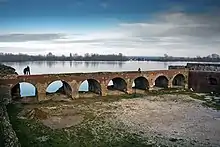| Šabačka tvrđava; Zaslon Шабачка тврђава; Заслон Böğürdelen | |
|---|---|
| Šabac | |
 Remains of the fortress | |
| Coordinates | 44°45′51″N 19°42′13″E / 44.7642°N 19.7036°E |
| Type | Strategic fortification |
| Site information | |
| Open to the public | Yes |
| Condition | Remains |
| Site history | |
| Built | 1471 |
| Built by | Isa-Beg Ishaković |
| Materials | Stone |
Šabac fortress (Serbian: Шабачка тврђава; Turkish: Böğürdelen Kalesi), is a fortress next to modern day Šabac, on the right riverbank of Sava.
History
Originally the location where the fortress was built was a trading square of the settlement known as Zaslon, where the merchants from Ragusa would trade their goods.
The fortress was built in 1471 by Isa-Beg Ishaković,[1] but soon afterwards, in 1476, it was captured by the Hungarian army with the help of the Serbian despot Vuk Grgurević and Vlad The Impaler,[2] who kept the Šabac fortress under his control for more than four decades. In 1521, on his campaign on the way to Belgrade, Suleiman the Magnificent captured Šabac.[3] As soon as he got hold of it, he had the earth palisade fortifications replaced with bulwark constructions with towers. In the period from 1717 until 1739, during temporary Austrian occupation, the fortress underwent significant adaptations and its surface was extended with additional construction of outer fortifications.
Gallery
References
- ↑ Panić-Surep, Milorad (1965). Yugoslavia: Cultural Monuments of Serbia. Turistička štampa. p. 79.
- ↑ Rudić, Srđan; Aslantaş, Selim (2017). State and Society in the Balkans Before and After Establishment of Ottoman Rule. Istorijski institut. p. 146. ISBN 9788677431259.
- ↑ Tucker, Spencer C. (2019). Middle East Conflicts from Ancient Egypt to the 21st Century: An Encyclopedia and Document Collection [4 volumes]. ABC-CLIO. p. 927. ISBN 9781440853531.





